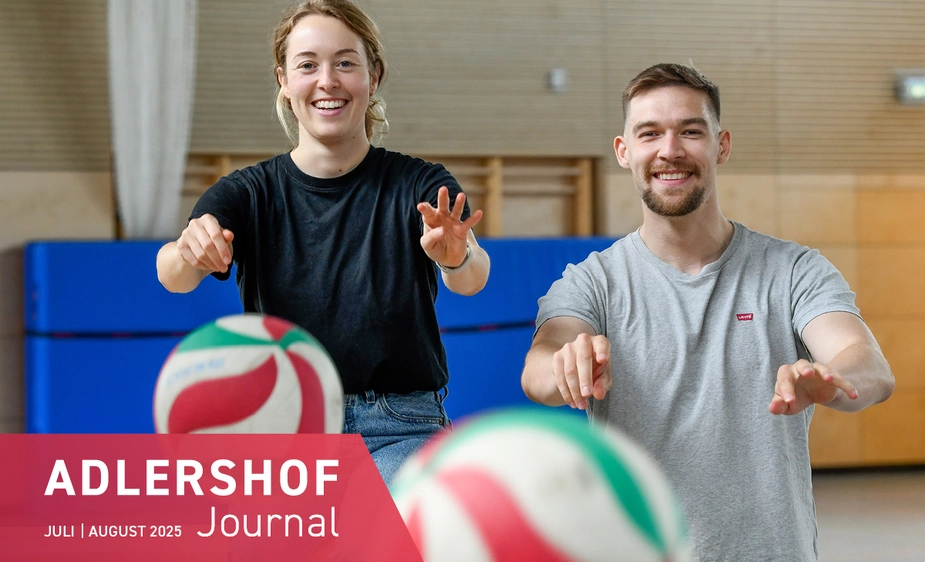Staying on the ball
Why Humboldt-Universität zu Berlin's sports campus in Adlershof is being expanded
With an increasing number of places in sports science courses, the demand for university sports courses is also growing. Because of this, Humboldt-Universität zu Berlin is set to expand its Adlershof sports campus.
It’s bright, spacious and superbly equipped: the new three-court sports hall on Rudower Strasse 18, at the corner of Wegedornstrasse. For just over a year, the newly built gymnasium has been providing ideal training conditions not only for sports science students, but also for people taking part in the university sports programme—and ample space.
Faced with growing demand, Selina Blatter, head of the university sports programme in Adlershof, is pleased with the new facilities: “We share the hall with the sports science department,” she says, walking across the grounds. “In the mornings, it’s used by sports science students and future PE teachers from Humboldt-Universität for their practical sessions. From late afternoon onwards, various recreational sports courses take place here.” They include ball games like basketball, badminton and volleyball, as well as gymnastics, fitness classes and circuit training.
In the past, the only available space was the old gym just a few metres from the new hall. That original building was renovated in 2018 and is still used. Owing to its wooden floor, the single-court gymnasium now primarily hosts dance classes such as ballroom, salsa or modern jazz, but also boxing and other martial arts, as well as table tennis. Next door, ballet and yoga classes are held in the dedicated gymnastics room, and another smaller room is equipped with spinning bikes.
Selina Blatter, who studied sports management and health education, has been responsible for planning and coordinating the entire course offering of the university sports programme in Adlershof for several years. She is also involved in the planning of new construction projects at the HU sports campus.
There’s more in the pipeline for the site. “There will be new outdoor facilities behind the new hall,” she says, pointing towards a large open space. Plans include a 400-metre running track, athletics facilities, a synthetic turf pitch, a rubber-surfaced basketball court and beach volleyball fields. Moreover, outdoor fitness equipment will be installed on the lawn in front of the old gymnasium. “If all goes well, construction will start next spring,” says Blatter.
Volleyball is one of the most popular sports among students. “Sometimes it feels like everyone in Adlershof plays volleyball,” says Henry Beiker, who has led volleyball courses every semester for the past four years. A computer science student who has just completed his master’s degree, Beiker has long noticed growing interest in the sport. “Half the physics student body is in my course, and almost two-thirds of the participants live close by,” says Beiker, who lives in neighbouring Johannisthal.
The new sports hall allows him to teach up to 40 students at once—six mixed teams playing simultaneously on three courts. He’s not quite sure what’s behind the boom. He would like to think it’s simply the quality of the courses, which has spread by word of mouth. People enjoyed coming, he says. The sessions also offer the chance to meet people across different fields of study. “The barrier to entry is really low in university sports,” adds Selina Blatter. “It’s easy to try out a new type of sport here.” She’s also noticed that interest in team sports has surged since the pandemic.
As of yet, around 6,000 students are enrolled at Campus Adlershof. Each semester, the campus offers 51 courses across a wide range of sports, with a total of roughly 900 spots available through the university sports programme.
The HU sport science programmes are based at Campus Nord in the city centre, but space is becoming increasingly scarce there, too. Looking ahead, two older buildings on the Adlershof site, currently used as the university archive, are set to be renovated and converted into seminar rooms. Once that is done, future teachers who are currently studying a course in the natural sciences as well as sports can not only complete the practical modules in Adlershof, but the theory as well.
Heike Gläser for Adlershof Journal
